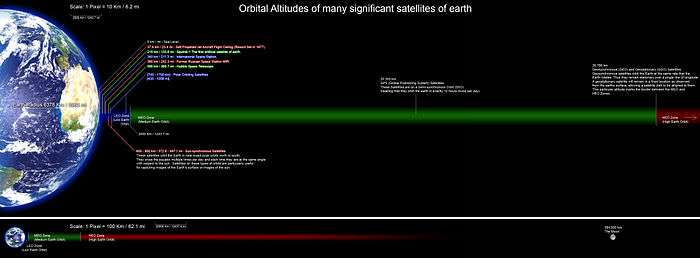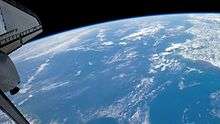Low Earth orbit

A low Earth orbit (LEO) is an orbit around Earth with an altitude between 160 kilometers (99 mi) (orbital period of about 88 minutes), and 2,000 kilometers (1,200 mi) (about 127 minutes). Objects below approximately 160 kilometers (99 mi) will experience very rapid orbital decay and altitude loss.[1][2] The orbital velocity needed to maintain a stable low Earth orbit is about 7.8 km/s, but reduces with increased orbital altitude.
With the exception of the manned lunar flights of the Apollo program, all human spaceflights have taken place in LEO or below. The International Space Station conducts operations in LEO. The altitude record for a human spaceflight in LEO was Gemini 11 with an apogee of 1,374.1 kilometers (853.8 mi). All manned space stations to date, as well as the majority of satellites, have been in LEO.
Orbital characteristics
Objects in LEO encounter atmospheric drag from gases in the thermosphere (approximately 80–500 km up) or exosphere (approximately 500 km and up), depending on orbit height. Due to atmospheric drag, satellites do not usually orbit below 300 km. Objects in LEO orbit Earth between the denser part of the atmosphere and below the inner Van Allen radiation belt.
The orbital velocity needed to maintain a stable low Earth orbit is about 7.8 km/s, but reduces with increased orbital altitude. Calculated for circular orbit of 200 km it is 7.79 km/s and for 1500 km it is 7.12 km/s.[3] The delta-v needed to achieve low Earth orbit starts around 9.4 km/s. Atmospheric and gravity drag associated with launch typically adds 1.3–1.8 km/s to the launch vehicle delta-v required to reach normal LEO orbital velocity of around 7.8 km/s (28,080 km/h).[4]

Equatorial low Earth orbits (ELEO) are a subset of LEO. These orbits, with low inclination to the Equator, allow rapid revisit times and have the lowest delta-v requirement (i.e., fuel spend) of any orbit. Orbits with a high inclination angle to the equator are usually called polar orbits.
Higher orbits include medium Earth orbit (MEO), sometimes called intermediate circular orbit (ICO), and further above, geostationary orbit (GEO). Orbits higher than low orbit can lead to early failure of electronic components due to intense radiation and charge accumulation.
Use of LEO

Although the Earth's pull due to gravity in LEO is not much less than on the surface of the Earth, people and objects in orbit experience weightlessness because they are in free fall.
A low Earth orbit is simplest and cheapest for satellite placement. It provides high bandwidth and low communication time lag (latency), but satellites in LEO will not be visible from any given point on the Earth at all times.[5]
Examples
- Earth observation satellites and spy satellites use LEO as they are able to see the surface of the Earth more clearly as they are not so far away. They are also able to traverse the surface of the Earth. A majority of artificial satellites are placed in LEO,[6] making one complete revolution around the Earth in about 90 minutes.
- The International Space Station is in a LEO about 400 km (250 mi) above the Earth's surface.[7]
- Since it requires less energy to place a satellite into a LEO and the LEO satellite needs less powerful amplifiers for successful transmission, LEO is used for many communication applications. Because these LEO orbits are not geostationary, a network (or "constellation") of satellites is required to provide continuous coverage. (Many communication satellites require geostationary orbits, and move at the same angular velocity as the Earth. Some communications satellites including the Iridium phone system use LEO.)
- Lower orbits also aid remote sensing satellites because of the added detail that can be gained. Remote sensing satellites can also take advantage of sun-synchronous LEO orbits at an altitude of about 800 km (500 mi) and near polar inclination. Envisat is one example of an Earth observation satellite that makes use of this particular type of LEO.
Space debris
The LEO environment is becoming congested with space debris due to the frequency of object launches. This has caused growing concern in recent years, since collisions at orbital velocities can easily be dangerous, and even deadly. Collisions can produce even more space debris in the process, creating a domino effect, something known as Kessler Syndrome. The Joint Space Operations Center, part of United States Strategic Command (formerly the United States Space Command), currently tracks more than 8,500 objects larger than 10 cm in LEO.[8] However, a limited Arecibo Observatory study suggested there could be approximately one million objects larger than 2 millimeters,[9] which are too small to be visible from Earth-based observatories.[10]
See also
- List of orbits
- Medium Earth orbit (MEO)
- High Earth orbit (HEO)
- Highly elliptical orbit (HEO)
- Geostationary orbit (GEO)
- Specific orbital energy examples
- Suborbital spaceflight
- Atmosphere of Earth
- Heavy lift launch vehicle
- Medium-lift launch vehicle
- Comparison of orbital launch systems
Notes
- ↑ Orbital periods and speeds are calculated using the relations 4π²R³ = T²GM and V²R = GM, where R = radius of orbit in metres, T = orbital period in seconds, V = orbital speed in m/s, G = gravitational constant ≈ 6.673×10−11 Nm²/kg², M = mass of Earth ≈ 5.98×1024 kg.
- ↑ Approximately 8.6 times (in radius and length) when the moon is nearest (363 104 km ÷ 42 164 km) to 9.6 times when the moon is farthest (405 696 km ÷ 42 164 km).
References
- ↑ "IADC Space Debris Mitigation Guidelines" (PDF). Inter-Agency Space Debris Coordination Committee. 15 October 2002.
- ↑ "NASA Safety Standard 1740.14, Guidelines and Assessment Procedures for Limiting Orbital Debris" (PDF). Office of Safety and Mission Assurance. 1 August 1995.
- ↑ "LEO parameters". www.spaceacademy.net.au. Retrieved 2015-06-12.
- ↑ Swinerd, Graham (2008). How Spacecraft Fly. Praxis Publishing. pp. 103–104. ISBN 0387765727.
- ↑ "High Throughput Satellite Communications Systems: MEO vs. LEO vs. GEO | The Link". www.harriscaprock.com. Retrieved 2015-11-28.
- ↑ Holli, Riebeek, (2009-09-04). "NASA Earth Observatory :". earthobservatory.nasa.gov. Retrieved 2015-11-28.
- ↑ "Higher Altitude Improves Station's Fuel Economy". NASA. Retrieved 2013-02-12.
- ↑ Fact Sheet: Joint Space Operations Center
- ↑ archive of astronomy: space junk
- ↑ ISS laser broom, project Orion
![]() This article incorporates public domain material from websites or documents of the National Aeronautics and Space Administration.
This article incorporates public domain material from websites or documents of the National Aeronautics and Space Administration.